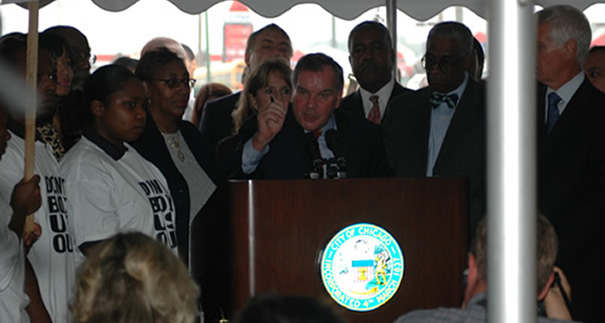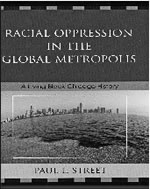In These Times forum features researcher Paul Street talking about racial injustice in the 'Global Metropolis'

 On Monday, October 15, 2007, scholar and former research director for the Chicago Urban League Paul Street, laid bare his arguments from a new book "Racial oppression in the Global Metropolis" at the Open University of the Left at In These Times on Milwaukee Ave.
On Monday, October 15, 2007, scholar and former research director for the Chicago Urban League Paul Street, laid bare his arguments from a new book "Racial oppression in the Global Metropolis" at the Open University of the Left at In These Times on Milwaukee Ave.
One of Street’s objectives is to pull away the veneer that white people use to masque the persistent racial inequalities permeating the city. He began the talk suddenly by jarring the audience with a seemingly endless barrage of disturbing statistics. The figures were derived from 1999 and the 2000 census. Some of starkest numbers were as follows;
• the black median income was 58 percent of white median income
• that black people in Chicago have 1/11th the wealth of white people
• of the city’s 15 poorest neighborhoods all but one was predominantly black
• two thirds of people in the state imprisoned for drug crimes are black — even though only 15 percent of the population is black.
After articulating this litany of discrepancies between black and white Chicago, Street made sure to emphasize the heart of his concerns, namely explaining what these differences have to do with racism. Drawing upon Stokely Carmichael and Stanley Hamilton’s conception of overt individual racism versus covert institutional racism, Street insists that the latter, what he calls “Level 2 Racism”, is still going strong.
Some examples of Level 2 racism would be separatist loans and discriminatory zoning practices. Street spent a good amount of time during the talk railing against Barack Obama, claiming that the refusal of the presidential candidate to acknowledge the structural basis for the racial wealth gap explains his appeal to whites.
Toward the end of the discussion Street provided the audience with a few more numbers
• that half of 17 to 30 year old black males have felonies
• that only four percent of the University of Chicago’s graduate students are black
• that less than one percent of partners in Chicago law firms are black.
Ultimately, though, Street encouraged the audience to create more spaces to challenge institutional racism by fighting the racial discrepancies in the war, opposing the Olympics and creating more spaces for interracial exchanges around quality of life issues. He left us with a Faulkner quote: “The past is never dead; it isn’t even past.”


